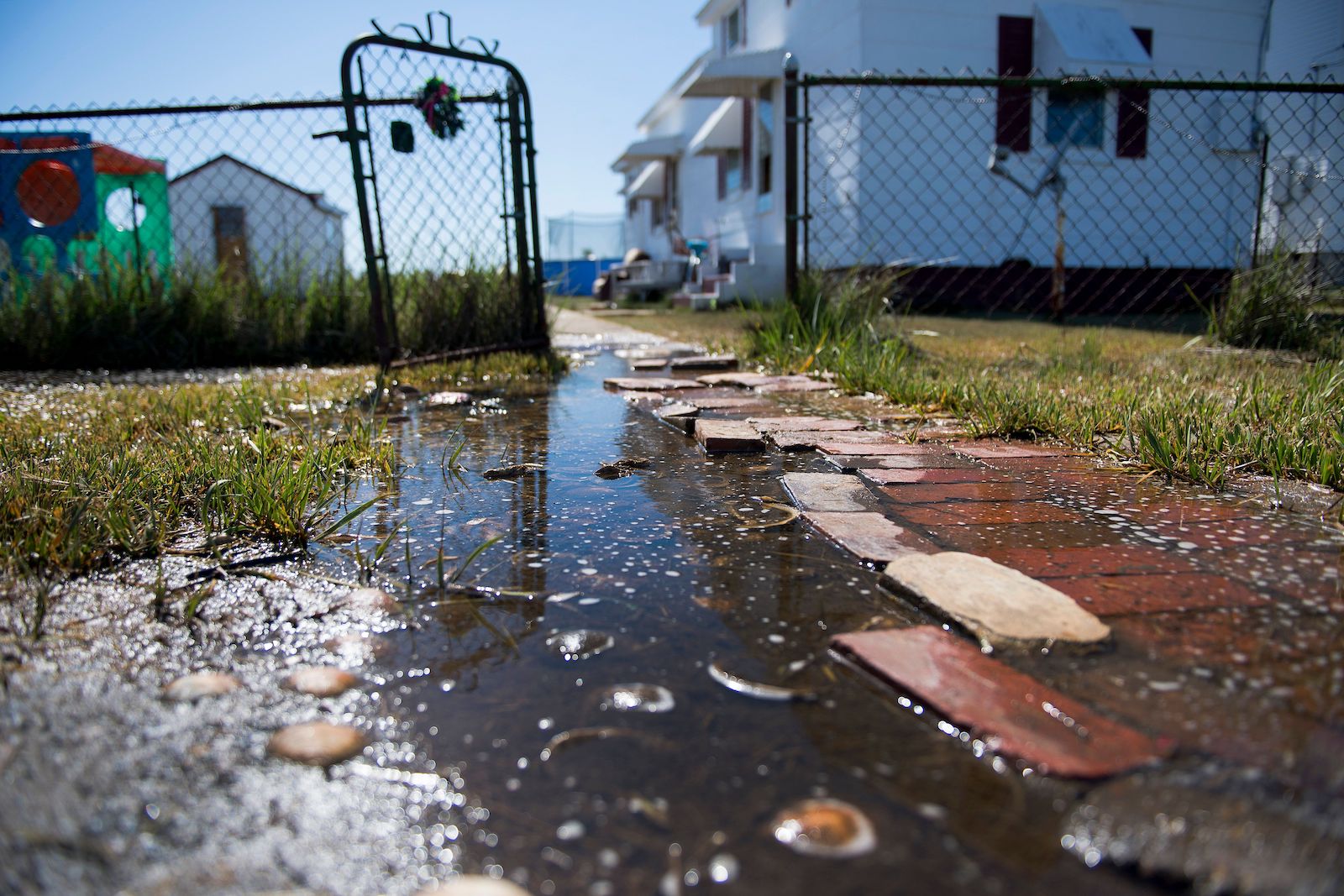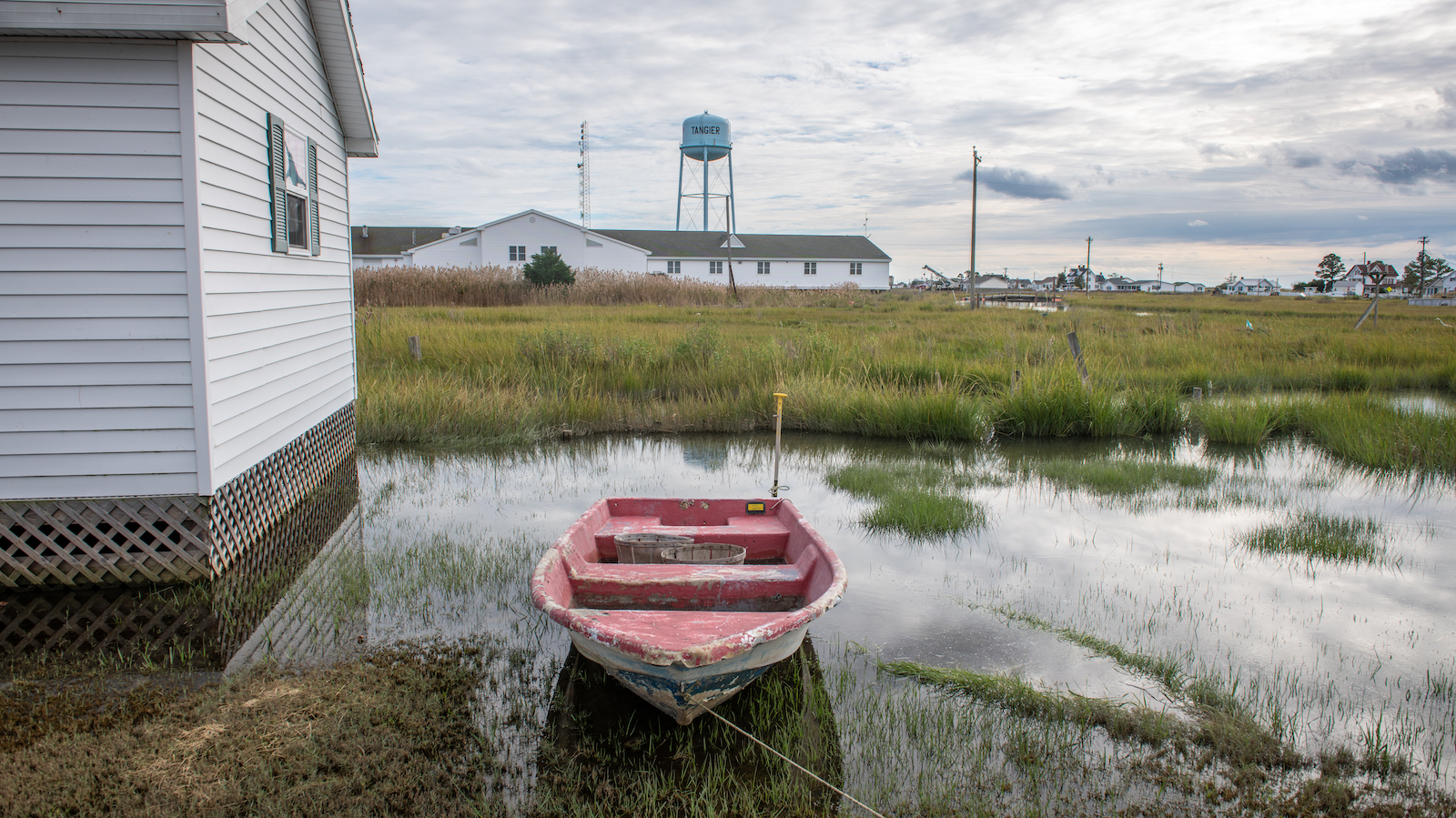Whenever David Schulte came home from studying Tangier Island in recent years, he couldn’t stop talking about what he was seeing. The spit of land in the Chesapeake Bay was washing away faster than any of the baseline predictions. Rising seas, spurred by climate change, had kicked erosion into overdrive, and the town, where people have lived for at least 200 years, was sinking under the waves.
His high-school aged son, Zehao Wu, listened with fascination. “It was all he could talk about at the dinner table,” Wu said. He was particularly struck by the plight of the islanders, most of whom lacked the resources to move elsewhere: The median household income on Tangier is $42,000 a year.
This week, Wu and Schulte, a marine biologist with the U.S. Army Corps of Engineers, published a paper in the journal Frontiers in Climate showing that Tangier Island has lost more than half its habitable area since 1967, and predicting that it will be totally uninhabitable by 2051 without drastic measures.
Those measures are mind-bogglingly expensive. Staving off erosion enough that residents could remain on the island would cost at least $250 million, the researchers found. Moving the entire town to the mainland, meanwhile, would come with a price tag between $100 to $200 million. Both are expensive propositions, especially considering the town has just under 400 residents. That breaks down to between $550,000 to $750,000 per person to stay, or $220,000 to $430,000 per person to leave.
Tangier Island is just one canary in a coal mine, signaling a much larger problem. Officials need to be preparing to relocate hundreds of communities, but there’s a stubborn attachment to place that keeps many people from moving, said Nicholas Pinter, who studies flooding at the University of California, Davis. “The city Pattonsburg, Missouri, moved after the 1993 flood — but it had been inundated 32 times before that,” Pinter said.
There are about 200 million people worldwide at risk of inundation by 2100, and that’s if countries manage to reduce greenhouse gas emissions. The numbers go up as emissions increase. Already, Boston is considering a mega barrier around its harbor, Norfolk is proposing a $1.4 billion seawall, and San Francisco is lifting buildings and moving freeways. The world is beginning to glimpse just how much work and money it will take “to do nothing.”
“People are going to start getting a wakeup call on just how much climate change is going to cost us,” Schulte said.

A wealthier community could afford to build seawalls, or might have the political connections to elicit government help. But the new research shows just how difficult it will be for smaller, low-income towns like Tangier to adapt. Schulte has worked on several plans to either move or protect communities from sea-level rise — all of them Native American villages with little money for resilience or relocation. The new infrastructure bill will provide some funding for that cause: It includes $47 billion for communities to prepare for floods, fires, and storms, with $100 million earmarked for moving Indigenous communities. But that’s a drop in the bucket. The Bureau of Indian Affairs has put a $5 billion price tag on the cost of moving Indigenous villages alone in the next 30 years.
“There is this very important disparity between those who are most affected by climate change and those who can afford to make the necessary adaptations,” Wu said. “That makes it more important for government to step in and help these people.”
In 2015, Schulte published a study in the journal Scientific Reports suggesting that the residents of Tangier Island would need to abandon the town between 2030 and 2065. The study received widespread media attention, and Wu waited for news that Tangier would finally get the help it needed, in the form of money, infrastructure, or guidance. Instead, the mayor of the town, James “Ooker” Eskridge, received a call from former president Donald Trump. “He said not to worry about sea-level rise,” Eskridge, an ardent Trump supporter, told reporters. “He said, ‘Your island has been there for hundreds of years, and I believe your island will be there for hundreds more.'”
It was a shock for Wu to see that no one acted: “I figured some help must be coming for these people, but no help came.”
If no one else was going to do anything, Wu decided he should. He began studying aerial photographs of the island over the years, and realized he could see the waters creeping up. Lowlands turned dark as the seawater penetrated the soil. It was easy to distinguish these spongey wetlands from the lighter highlands, he said. He realized that if he plugged these images into mapping software, he’d be able to accurately chart the rate of inundation.
“When he showed me the results, I got pretty excited,” Schulte said. Wu had figured out a way to strengthen a weakness of his dad’s 2015 paper, which based its predictions on the shrinking of the entire island rather than focusing in on the parts that mattered — the ridges where people live, which stand two to five feet above sea level.
The paper’s findings suggest that sea-level rise is eroding these ridges more rapidly than previously thought. All the islands in the Chesapeake Bay are eroding, and several disappeared before the onset of climate change. Rising seas are accelerating the process. The first ridge will complete its conversion to wetlands by 2033, the second by 2035, and the highest and smallest ridge by 2051, Wu and Schulte predict. The impacts are already clear: The pair found that the population of the town has declined by more than half as the livable area shrunk.
“When your front yard is converted into a swamp over the course of your life you tell your grandkids, ‘You’ve got to leave,’” Schulte said.



